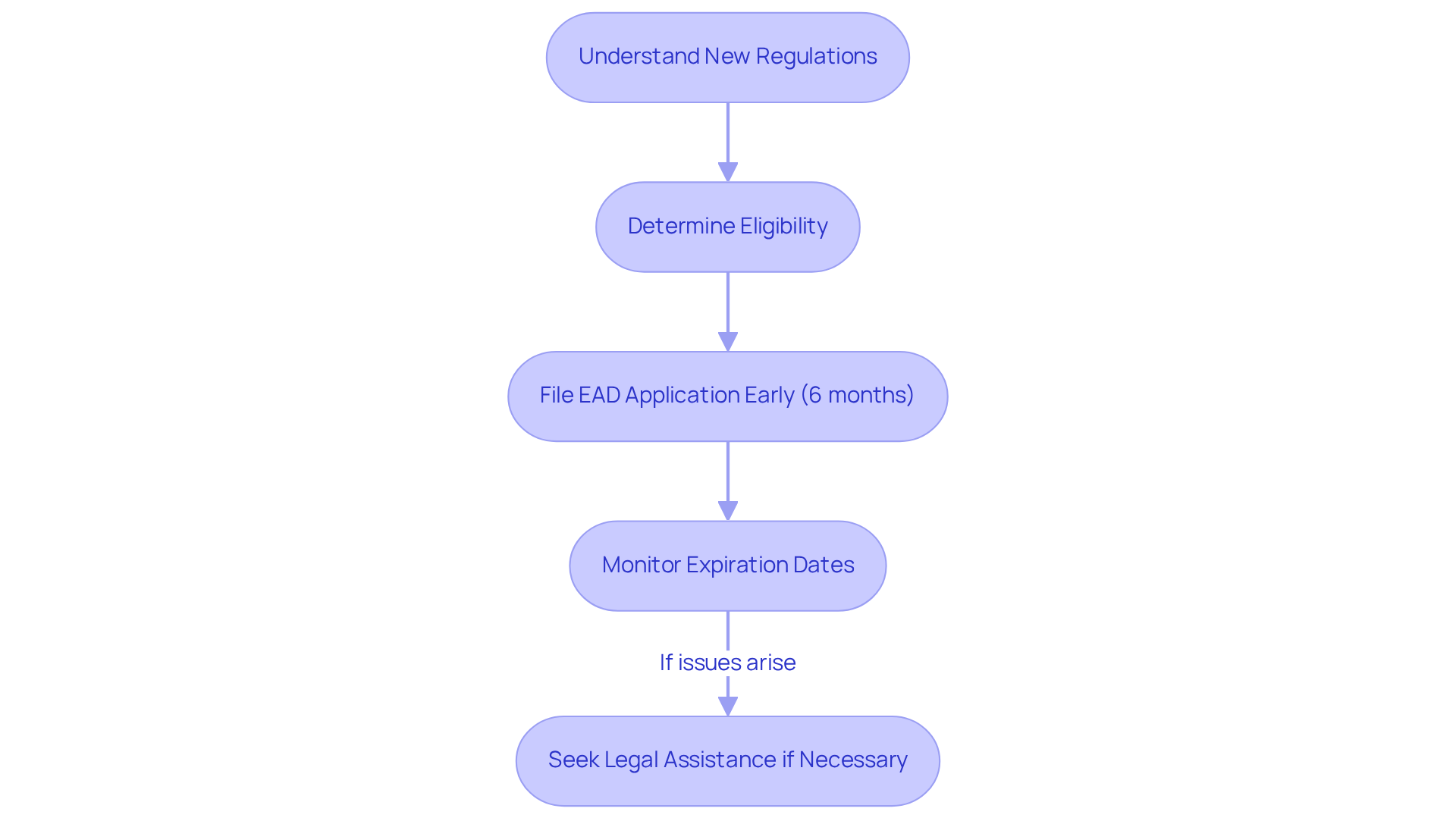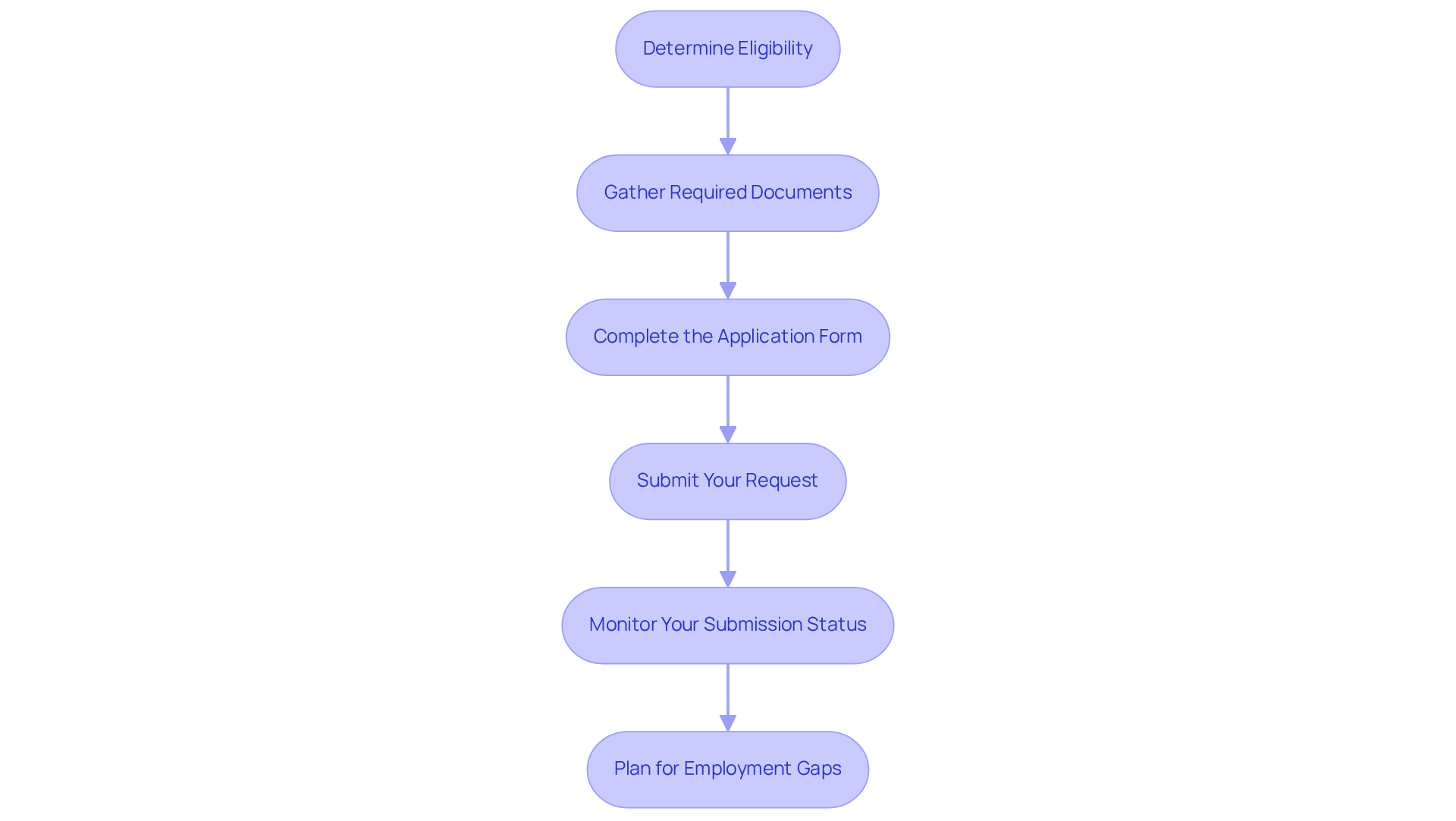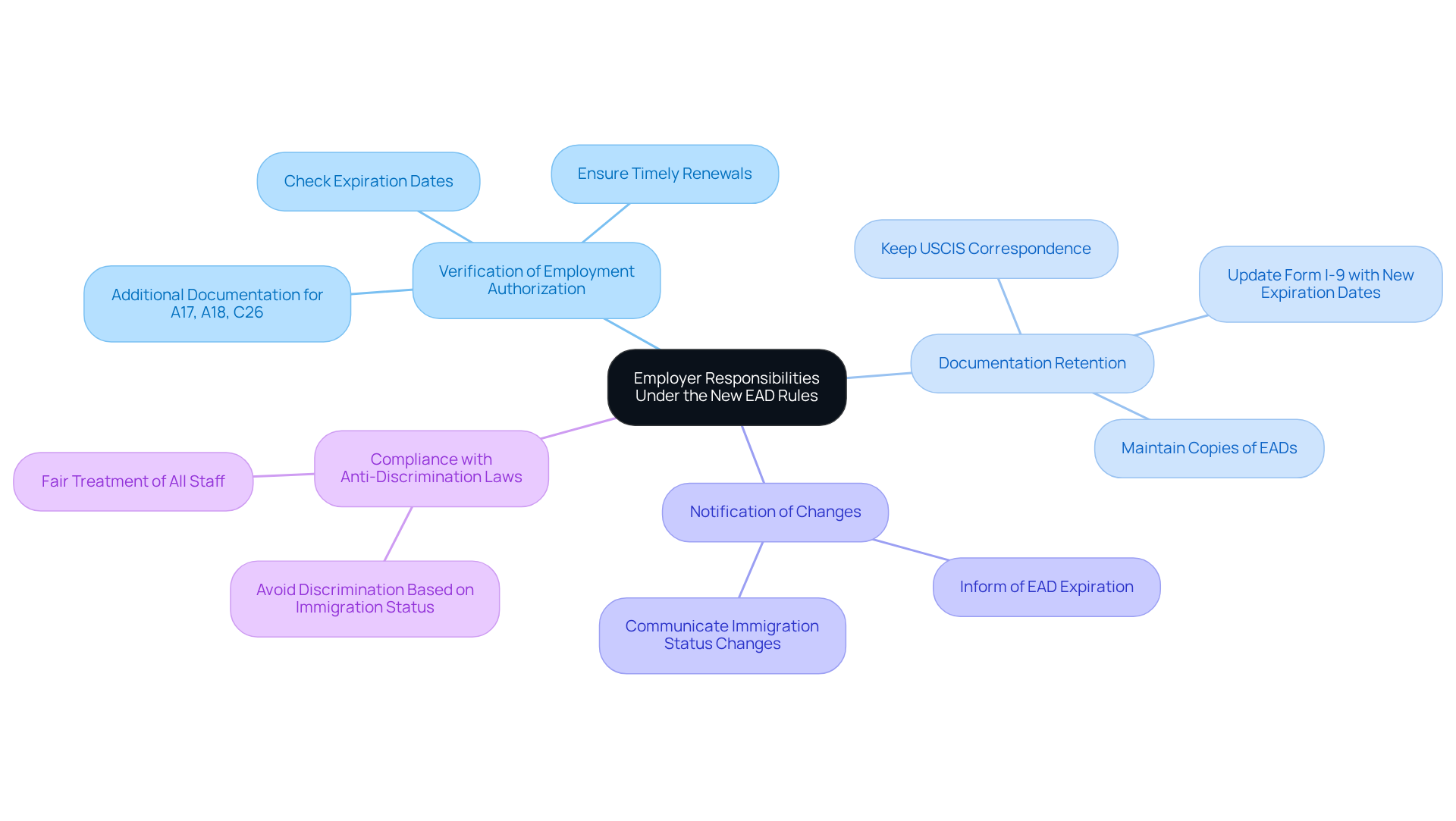Overview
Navigating the recent changes in the Employment Authorization Document (EAD) extension process can feel overwhelming for immigrant workers. The elimination of the automatic extension period for many EAD categories is a significant shift that demands attention. Have you ever felt lost in the immigration process? It’s crucial to apply for renewals up to six months in advance to avoid gaps in your work authorization.
But it’s not just about individual action; employers also face increased responsibilities. They must ensure compliance and manage documentation effectively. We understand how stressful this can be, but you’re not alone in this fight. We’re here to guide you every step of the way, ensuring you know your rights and the actions you can take.
Remember, timely action is key. Don’t wait until it’s too late—take charge of your situation now. Your future matters to us, and we’re committed to fighting for your family. Yo Peleo — We Fight.
Introduction
Recent updates to the Employment Authorization Document (EAD) extension process are reshaping the landscape for immigrant workers. These changes introduce new regulations that demand immediate attention. They aim to streamline the application process but also place greater responsibility on both employees and employers to ensure compliance and avoid employment gaps.
Have you ever felt overwhelmed by confusing immigration processes? As the stakes rise, how can immigrant workers effectively navigate these complexities to secure their work authorization and protect their rights? It’s important to know you have rights, even if others tell you otherwise. We understand how challenging this environment can be, but you don’t have to face it alone—we’re here to fight for you.
Overview of EAD Extension Changes
Recent changes to the EAD extension process have introduced important regulations that impact immigrant workers' ability to apply for and maintain their work authorization. These modifications aim to simplify the EAD extension procedure and address the delays that have plagued EAD renewals. Notably, the automatic extension period for certain EADs has been eliminated for submissions made on or after October 30, 2025. This means that individuals renewing their EAD extension must now take proactive steps to manage their requests and avoid gaps in employment authorization.
Key updates include a shift in eligibility criteria and documentation requirements. The automatic extension period, which was previously set at 540 days, is now limited. For instance, timely submitted STEM OPT extension requests will still receive a 180-day automatic extension, while many other categories, including adjustment of status candidates and H-4 spouses, will no longer benefit from the EAD extension renewals. This change requires immigrant workers to file their EAD extension applications as early as six months before their current EAD expires to ensure continuous work authorization.
In light of these changes, it’s crucial for immigrant workers to understand their rights and the immediate actions they should take if they face legal emergencies, like receiving a subpoena or encountering ICE enforcement. Workers have the right to:
- Remain silent
- Have an attorney
- Not sign documents without legal counsel
If you find yourself in a situation involving ICE enforcement actions, deportation proceedings, or any criminal charges, it’s vital to reach out for legal assistance right away. Our emergency line is available 24/7 for urgent legal matters, ensuring that your rights and freedom are protected.
The implications of these updates are significant. Employers must now actively monitor the expiration dates of their workers' EAD extensions and may need to let go of individuals who cannot provide valid work authorization by the expiration date. This change places additional responsibility on both employers and workers to maintain compliance and prevent job disruptions. Failing to meet these requirements could lead to serious consequences for employers, including potential penalties and the need to manage payroll and benefits for employees whose work authorization has lapsed.
Therefore, staying informed about these changes is essential for immigrant workers navigating the complexities of their immigration status and work rights. Remember, we’re here to fight for your family and ensure your future matters.

Impact on Foreign Nationals and Employment Categories
Recent changes to the EAD extension process are shaking things up for many foreign nationals. Have you ever felt lost in the immigration process? Healthcare professionals, who often face unique challenges in maintaining their legal status, could benefit from streamlined processing methods that help them secure and retain jobs. For students on Optional Practical Training (OPT), the new eligibility criteria might impact their job prospects after graduation, making it crucial to pay close attention to these regulations.
Moreover, individuals with H-4 or L-2 visas may find their EAD application timelines altered, adding another layer of complexity to their job situations. We understand how overwhelming this feels. It’s vital for employers to partner with HR professionals or PEOs to navigate the intricacies introduced by the EAD extension changes. Employers must also keep a close eye on EAD extension expiration dates and re-verify work eligibility to avoid compliance issues. Ignoring these responsibilities could lead to audits, fines, and damage to their reputation.
Clear communication with affected employees is essential to maintain morale and ensure compliance with evolving regulations. Remember, your future matters to us. Understanding these changes is key for foreign nationals to effectively navigate their job opportunities and stay compliant with the law. We’re here to fight for your family.

Steps to Navigate the New EAD Application Process
Navigating the new EAD application process can feel overwhelming, but you’re not alone. Here’s how to tackle it step by step:
- Determine Eligibility: Start by reviewing the updated eligibility criteria. Make sure you qualify for an extension of your EAD based on your immigration status and job category.
- Gather Required Documents: Collect all necessary documentation, like proof of employment, previous EAD cards, and any supporting evidence needed under the new rules. Remember, photos submitted to USCIS must be unmounted and unretouched to avoid delays.
- Complete the Application Form: Fill out Form I-765 accurately, ensuring all information is current and reflects your situation. Don’t forget to file Form I-765 within 6 months of your current EAD extension’s expiration date for renewals.
- Submit Your Request: Send your request to the appropriate USCIS service center, following any new submission guidelines. Be aware that new fees for Form I-765 will apply to benefit requests postmarked on or after July 22, 2025.
- Monitor Your Submission Status: After you submit, check your status online regularly. Be ready to respond to any requests for additional information from USCIS. Processing times for EAD renewal requests can take up to 90 days, so plan accordingly.
- Plan for Employment Gaps: If your EAD is close to expiring, look into options for maintaining employment during the processing period, like applying for an interim EAD if you’re eligible. If you’re renewing your EAD extension based on a pending Form I-589, ensure that you submit the necessary evidence to support your request.
By following these steps, you can navigate the new EAD application process with confidence. Remember, we’re in this fight together, and we’re here to support you every step of the way.

Employer Responsibilities Under the New EAD Rules
Under the new EAD regulations, employers face important responsibilities to ensure compliance with immigration laws.
-
Verification of Employment Authorization: Employers must confirm that workers have valid Employment Authorization Documents (EADs) and that they hold the appropriate EAD extension to work in the U.S. This means checking expiration dates and ensuring renewals are filed on time. Notably, individuals under category codes A17, A18, and C26 need extra documentation to show their EAD extension has been automatically granted.
-
Documentation Retention: Keeping accurate records is essential. Employers are required to maintain copies of workers' EADs and any correspondence with USCIS about work authorization. For instance, if a worker's Form I-797 for their EAD renewal application indicates a 180-day extension and remains pending after a specified date, they may qualify for an additional EAD extension of 360 days, totaling 540 days.
-
Notification of Changes: It’s crucial for employers to be informed promptly if a worker's EAD is nearing expiration or if there are changes in their immigration status. This proactive communication helps prevent lapses in work authorization.
-
Compliance with Anti-Discrimination Laws: Employers must adhere to anti-discrimination laws, ensuring that all staff members are treated fairly, regardless of their immigration status.
Statistics from 2025 show that many employers are still navigating the complexities of EAD verification, underscoring the importance of these responsibilities. For example, employers managing EAD compliance for immigrant workers have reported improvements by integrating automated reminders for EAD renewals and keeping updated records in their HR systems. Additionally, when applicable, employers must enter 'ead extension' in the Additional Information field in Section 2 of Form I-9.
By understanding and fulfilling these responsibilities, employers can help create a smoother EAD extension application process for their immigrant employees, ensuring compliance and minimizing disruptions in employment. Remember, we’re here to fight for your family and support you every step of the way.

Conclusion
The recent updates to the EAD extension process bring significant changes that require immigrant workers to take charge of their work authorization. With the automatic extension period eliminated for many categories, it’s crucial to file EAD applications well ahead of expiration to prevent any employment gaps. Understanding these new regulations is essential for navigating the complexities of immigration status and work rights effectively.
Throughout this article, we’ve highlighted key points:
- The revised eligibility criteria
- The importance of timely application submissions
- The responsibilities employers must uphold to ensure compliance with the new rules
Immigrant workers need to stay informed about their rights, especially during legal emergencies, while employers must keep accurate records and communicate clearly with their employees about EAD expirations.
In conclusion, the evolving landscape of EAD extensions emphasizes the need for both immigrant workers and employers to adapt to these changes. Staying informed and taking proactive steps can help mitigate the risks of employment disruptions. It’s vital for everyone involved to prioritize compliance and communication, ensuring a smoother navigation through this challenging process. Your future matters, and being well-prepared is the key to safeguarding your rights and opportunities in the workplace. Remember, we’re here to fight for your family, and together, we can tackle these challenges head-on.
Frequently Asked Questions
What are the recent changes to the EAD extension process?
Recent changes to the EAD extension process include the elimination of the automatic extension period for certain EADs for submissions made on or after October 30, 2025. This aims to simplify the extension procedure and address delays in EAD renewals.
What is the new automatic extension period for EAD renewals?
The automatic extension period has been reduced; timely submitted STEM OPT extension requests will still receive a 180-day automatic extension, while many other categories, including adjustment of status candidates and H-4 spouses, will no longer benefit from automatic extensions.
When should immigrant workers file their EAD extension applications?
Immigrant workers should file their EAD extension applications as early as six months before their current EAD expires to ensure continuous work authorization.
What rights do immigrant workers have in legal emergencies involving ICE enforcement?
Immigrant workers have the right to remain silent, have an attorney present, and not sign documents without legal counsel.
What should workers do if they face ICE enforcement actions or legal issues?
Workers should reach out for legal assistance immediately if they encounter ICE enforcement actions, deportation proceedings, or any criminal charges. An emergency line is available 24/7 for urgent legal matters.
How do these changes affect employers?
Employers must actively monitor the expiration dates of their workers' EAD extensions and may need to let go of individuals who cannot provide valid work authorization by the expiration date, placing additional responsibility on both employers and workers.
What are the consequences for employers if they fail to comply with the new EAD extension requirements?
Failing to meet these requirements could lead to serious consequences for employers, including potential penalties and the need to manage payroll and benefits for employees whose work authorization has lapsed.




